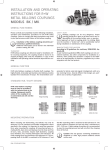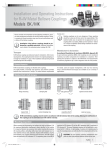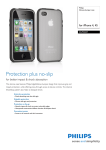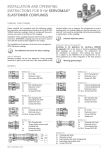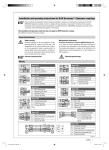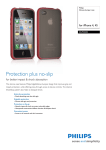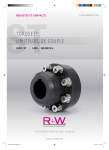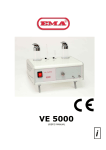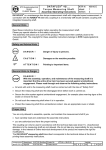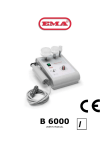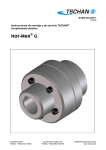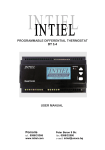Download Installation and operating instructions for R+W Servomax
Transcript
Installation and operating instructions for R+W Servomax® - Elastomer couplings Please carefully and completely read the following installation, operation and maintenance procedures for the R+W SERVOMAX elastomer couplings. Failure to comply with these procedures may result in the failure of the coupling. Installation of the couplings should be performed by a qualified technician. SERVOMAX couplings may only be used in accordance with the technical data supplied in the catalog. General functioning R+W SERVOMAX elastomer couplings are flexible shaft couplings, backlash free torque transmission is achieved through a pre-tensioned elastomer insert. The coupling compensates for lateral, axial, and angular misalignment. It is also possible to vary the stiffness and dampening effect of the coupling by using inserts with different derometers (hardness). A number of different hub design have been created to accommodate numerous applications. - key connection - clamping hub connection - tapered clamping ring connection. Models EK 1 Key connection Parts list 1 hubs 2 elastomer insert 3 set screws DIN 916 EK 2 EKL clamping hub connection Parts list 1 clamping hubs 2 elastomer insert 3 clamping screws DIN 912 / 12.9 EK 6 tapered clamping ring connection Parts list 1 tapered hubs 2 elastomer insert 3 tapered clamping rings 4 clamping screws DIN 912 / 12.9 General Information R+W SERVOMAX couplings are delivered ready for installation. After incoming inspection the coupling should be stored in its original packaging until it is ready for installation. A copy of this installation, operation, and maintenance manual should be kept with the coupling. Safety warning Rotating couplings can be very dangerous. Proper guarding should be in place at all times and is the responsibility of the machine builder, user or operator. Do not approach or touch a coupling while it is rotating. Make sure that the machine is "locked out” and cannot be accidentally started during installation or maintenance of the coupling. Indicates important points Manufacturer’s declaration According to EG guidelines for machinery 89/392 EWG Appendix 11B In the sense of machine guidelines (MR) shaft couplings are no machines, but components for the installation in machines. Their putting into operation is subject to the fulfillment of all requirements of machine guidelines by or after integration in the final product. Warning against danger Mounting preparation All mounting surfaces including shafts, bores, keys and key ways, must be clean and free of burrs, nicks and dents. Inspect shaft diameters, coupling bore diameters, key and key-way dimensions and tolerances. All R+W coupling bores are machined to ISO tolerance H7.Clearances between the shaft and hub are maintained to be within 0.01 and 0.05 mm. A light coating of oil is recommended to ease the mounting process and will not affect the clamping force of the hub. CAUTION: Do not use sliding grease, or oils or grease with molybdenum disulfide or other high pressure additives. CAUTION: The maximum permissible bore diameters D1 and D2 (see catalog) must not be exceeded! The coupling may burst if these values are exceeded. Serious injury or death may result from flying debris. Do not clamp here Figure 1 During manufacturing the concentricity and run-out of the coupling hub are precisely controlled. Applying excess forces on the jaw end of the hub will deform the coupling negatively affecting its performance. Custom modification of the coupling hub is possible by the customer. The hub may be custom machined to a maximum dimension (H) (see catalog for specific values). The customer assumes all responsibility for the performance of the coupling anytime a modification is made. R+W cannot guarantee the performance of the coupling once the customer performs any modification to the original design. Consult your R+W representative for custom design technical assistance. Figure 2 Elastomer ring The key element of the SERVOMAX coupling is the elastomer insert. It compensates for axial, lateral, and angular misalignment while dampening vibration and absorbing shock loads. Several elastomer insert are available with different hardness values that affect the performance of the coupling. Design A Shore hardness 98A (red color) Elastomer ring Design B Shore hardness 64D (green color) m) r me high torsional-stiffness n s sig rie Se 10 20 60 150 high absorption g rin 300 450 De n mi No to al . TKmax A 10 15 B 12 20 A 17 34 B 21 42 A 60 120 B 75 150 A 160 320 B 200 400 A 325 650 B 405 810 A 450 900 B 560 1120 tom e ax qu tor M TKN ) ing Fit me DE 11,5 13,2 19 20 24 26 18,2 27,2 30,2 38,2 46,2 l era lat dia A 17 m) (m las (e ter gth n Le e) gre (de rr e e rqu sto (m (m (N ) a (el m) m) m) (N lar ial gu an ax max. value 0,08 1 ±1 0,06 0,8 ±1 0,08 1 ±2 0,06 0,8 ±2 0,1 1 ±2 0,08 0,8 ±2 0,12 1 ±2 0,1 0,8 ±2 0,14 1 ±2 0,12 0,8 ±2 0,16 1 ±2 0,14 0,8 ±2 Table 1 CAUTION: The maximum permissible misalignment values stated in the chart are based on the following parameters: Nominal torque TKN, rotational speed n=1500 rpm and a ambient temperature of 10 to 30 C°. To achieve zero backlash the coupling hubs must be pressed together with an axial force (F) compressing the elastomer ring. Cleaning the elastomer ring and hubs and applying a light film of oil will aid in the assembly process. (Figure 3). = Fit length F Mounting force Caution! Use PU – compatible greases such as e.g. vaseline. Contact surfaces Figure 3 Mounting EK 1 Access hole Slide a coupling half onto the shaft to the correct axial position. Tighten the set screw(s) to the appropriate torque using a torque wrench. Insert the elastomer ring and press the two coupling halves together. Make sure that the fit length (A) is maintained. (See table 1) Mount the assembled coupling onto the second shaft and tighten the set screw(s). Spindle Dismounting: Loosen the set screws and remove the coupling. Use an appropriate tool that will not damage the coupling to pry the coupling halves apart. Set screws DIN 916 Mounting EKL / EK 2 Access hole Access hole m) m) (N (m ) 2.9 2/1 the of ue w r q r o e ete c d g t scr g s enin ing diamhea ce n i r n t n h te te w an ste Tig fas Ou scre Dist Fa IN (E) Screws DIN 912 rew Spindle s rie Se E (E) Screws DIN 912 Slide a coupling half onto the shaft to the correct axial position. Using a torque wrench, tighten the clamp screw (E) to the appropriate torque indicated in Table 2. Insert the elastomer ring and press the two coupling halves together. Ensure that the fit length (A) is maintained. (See table 1). Mount the assembled coupling onto the second shaft and tighten the clamp screw (E). Access hole Spindle Dismounting: Simply loosen the clamp screw (E) and remove the coupling. Use an appropriate tool that will not damage the coupling to pry the coupling halves apart. (E) Screws DIN 912 91 (D BS F 10 M4 4 32 9,5 20 M5 8 44,5 15 60 M6 15 57 21 150 M8 40 68 24 300 M10 60 85 29 450 M12 120 105 38 Table 2 Mounting EK 6 (E) Screws DIN 912 m) (E) Screws DIN 912 ) 2 .9 /12 91 s rie Se Spindle Spindle (E) Screws DIN 912 Positive stop 4 he ft (N m) (m IN eo (D r qu w rew g tor scre meted n i ing dia hea n n i n hte ten ter w ste Tig fas Ou scre Fa c gs E 20 6 x M4 3 M4 60 4 xM5 6 M5 The EK6 uses a clamping ring with axial fastening screws M5 150 8 x M5 6 (E). Slide the coupling hub onto the first shaft, using a torque wrench, uniformly tighten the clamping screws (E) 300 8 x M6 12 M6 using a cross-wise tightening pattern until all the clamping screws are evenly tightened to the correct tightening 450 8 x M8 35 M8 Table 3 torque as given in table 3. The clamping ring will come to a positive stop (1). This avoids excessive loading of the clamping ring and improves the TIR (Total Indicator Run-out) of the coupling on the shaft. Insert the elastomer ring. The other coupling hub is mounted onto the second shaft end using the same procedure. Press the two coupling halves together and ensure that the fit length (A) is maintained (See Table 1). Dismounting: Pull the coupling halves apart and remove the axial fastening screws (E). Threaded holes have been machined into the hub to accept the fastening screws which will now be used to push off the tapered ring (figure 4). CAUTION: Prior to re-assembly make sure the fastening screws are in the proper holes to draw in the taper ring. m) (m Maximum Shaft misalignment R+W SERVOMAX elastomer couplings compensate for lateral, axial, and angular shaft misalignment. Lateral misalignment axial misalignment angular misalignment In Table 1 you will find the maximum permissible values for the three axis of misalignment. It is important to remain within these limits to ensure long life and proper operation of the coupling. If several misalignment types occur at the same time, it is necessary to reduce the maximum permissible misalignment values. The percentage of the maximum value summing up actual misalignments must not exceed 100 %. CAUTION: Lateral misalignment has a negative effect on the service life to the elastomer. Exact alignment of the coupling considerably increases the service life of the elastomer. By reducing or eliminating lateral misalignment the radial loading of the adjacent bearings is eliminated increasing service life and reducing heat. For drives running at high speed we recommend aligning the R+W coupling with a dial indicator (figure 4 & 5). Attachment with intermediate flange If an R+W SERVOMAX coupling is to be installed within a intermediate flange, it is important that the drive and driven shafts align as precisely as possible. The flange must be precision machined with centering pilots, and the mounting surfaces must be parallel to each other and perpendicular to the shaft axis. Intermediate flange is fixed Spindle Caution! Do check fit length (A) indicated in table 1. The elastomer ring must be axially movable. Spindle dial gauge or lever gauge Figure 4 magnet measuring support Open installation If the R+W SERVOMAX coupling is to be mounted between a foot mounted motor and a gearbox for example, care must be taken to ensure that the gearbox and motor shafts are in alignment and the devices are permanently mounted. 90° turn is sufficient Spindle Caution! Do check the fit length A indicated in table 1. The elastomer ring must be axially movable. Figure 5 Maintenance R+W Antriebselemente GmbH Alexander-Wiegand-Str. 8 · 63911 Klingenberg Tel. +49-(0)93 72 – 98 64-0 · Fax +49-(0)93 72 – 98 64 20 [email protected] · http://www.rw-couplings.com The above-mentioned information is based on our present knowledge and experiences and does not free the user of his own regular checks. A legally binding guarantee is not given even in regard to protection rights of Third parties. 247/02/02/2000 R+W SERVOMAX couplings are maintenance-free as long as they are properly mounted and the maximum misalignment values are not exceeded. Extreme ambient or installed conditions such as very high or low temperatures, acidic or basic solutions, cutting fluids, etc. may cause wear and tear on the elastomer insert. Regular inspection of the insert is recommended. If replacement is required use only R+W original spare parts.





